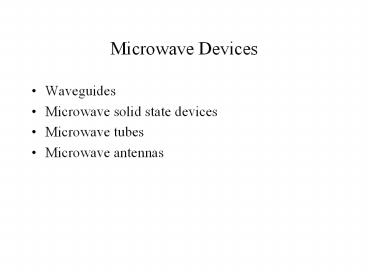Microwave Devices - PowerPoint PPT Presentation
1 / 35
Title:
Microwave Devices
Description:
Microwave Devices Waveguides Microwave solid state devices Microwave tubes Microwave antennas Preamble As frequency increases beyond the lower boundary that has been ... – PowerPoint PPT presentation
Number of Views:955
Avg rating:3.0/5.0
Title: Microwave Devices
1
Microwave Devices
- Waveguides
- Microwave solid state devices
- Microwave tubes
- Microwave antennas
2
Preamble
- As frequency increases beyond the lower boundary
that has been assigned as the microwave threshold
(1 Ghz) conventional R.F. techniques become less
effective. - Lead inductance and capacitiance as well as
connecting traces on substrates become issues
affecting circuit performance. - An example is TRANSIT TIME.
- Physical construction of devices must change.
3
Waveguides
- Conventional transmission lines develop too much
loss at microwave frequencies. - Hollow waveguides present an alternative.
- Electromagnetic waves reflect from the walls of
the wave guide as it travels its length. - Brass, aluminum or silver plated.
- RECTANGULAR, elliptical and circular.
4
(No Transcript)
5
Waveguides
- No radiation losses as E and H fields are
contained. - Dielectric losses are small. (air)
- Minimal losses in conductive walls.
6
Waveguide Modes
- A waveguide operates most efficiently within
modal boundaries. - A given waveguide cross section will have a
cutoff frequency where a signal below it will not
propagate. - What type of filter does this act as?
- Not all modes strike the walls at the same angle
therefore the distance traveled varies. - This is called multimode propagation.
- Effective velocity reduces.
- Pulse spreading results and subsequent pulses
following closely will interfere. (Dispersion)
7
fc cutoff frequency
8
Waveguide Modes
- Singlemode operation is achieved by using the
mode with the lowest cutoff frequency. (Dominant
mode) - Waveguide is used between its cutoff frequency
and that of the mode of the next lowest cutoff
frequency. - TE or TM modes.
9
of variations along b
of half cycles along a
10
(No Transcript)
11
(No Transcript)
12
Group velocity- used to determine the length of
time a signal takes to travel the length of the
waveguide.
13
(No Transcript)
14
Phase velocity- used to determine wavelength in a
guide. It is the rate at which a wave appears to
move along a wall of a guide based on the way the
phase angle varies along the guide.
15
(No Transcript)
16
Impedance of a waveguide.
17
The calculation for wavelength in a guide
requires phase velocity.
18
(No Transcript)
19
(No Transcript)
20
(No Transcript)
21
Bends and Tees
- BENDS if the transition through the bend is
gradual there will be a minimal effect. - TEES
- gtE plane tee output is out of phase with the
input. (series tee). - gtH plane tee is in phase with the input.
(shunt tee)
22
(No Transcript)
23
Bends and Tees
- HYBRID or MAIC TEE
- If the input is to Port 3
- Output is at port 1 and 2 in phase
- Port 4 does not have an output.
- If input is to port 4
- Output is at port 1 and 2 out of phase
- Port 3 does not have an output
- Note a termination component develops 3 dB loss.
24
(No Transcript)
25
(No Transcript)
26
Cavity Resonator
- ½ wavelength section
- Waves reflect end to end and in phase with the
incident signal. - Field strength will build
- Resonant cavity Q is on the order of several
thousand. - Can be made tunable with an adjustable short
circuiting plate. - Ex. Wavemeter.
27
(No Transcript)
28
Attenuators and Loads
- Carbon can be used.
- As a field becomes present in the carbon a
current flows developing a power loss. - A carbon flap is inserted and presented over a
varying degree.
29
(No Transcript)
30
Circulators and Isolators
- ISOLATOR permits a signal to pass in only one
direction. Other direction is attenuated.Ex.
Protects a source from a mismatched load.
Reflected power is dissipated. - CIRCULATOR Separates signals. Signal applied to
one port will only emerge at the next port. - Ex. Transmit/receive switch.
31
Circulators and Isolators
- PRINCIPLE OF OPERATION
- Fields interact with a ferrite. (magnetically)
- Ferrites can be comprised of ceramic compounds of
iron oxide with other metals. - Ferromagnetic and non conductive. Permeability
greater than air.
32
Circulators and Isolators
- PRECESSION
- When axis of a rotating electron also spins.
- A magnetic field can be adjusted to control the
frequency at which precession occurs in a
ferrite. - If a magnetic field propagates through the
ferrite and signal (wave) frequency equals
precession frequency the magnetic field can then
adjust precession frequency up nor down. - For isolator
- If precession increases signal energy is removed.
- If precession decreases minimal loss.
33
Circulators and Isolators
- For Circulator
- A magnetic field acting upon a ferrite also
develops a phase shift as the wave propagates
through the material. - Faraday rotation.
- Similar to polarization shift for some
frequencies paasing through the ionosphere. - Quantity of phase shift is determined by the
length of ferrite and the strength of the dc
magnetic field. - Correct selection of phase shifts will add fields
at some ports while canceling at others.
34
(No Transcript)
35
(No Transcript)































